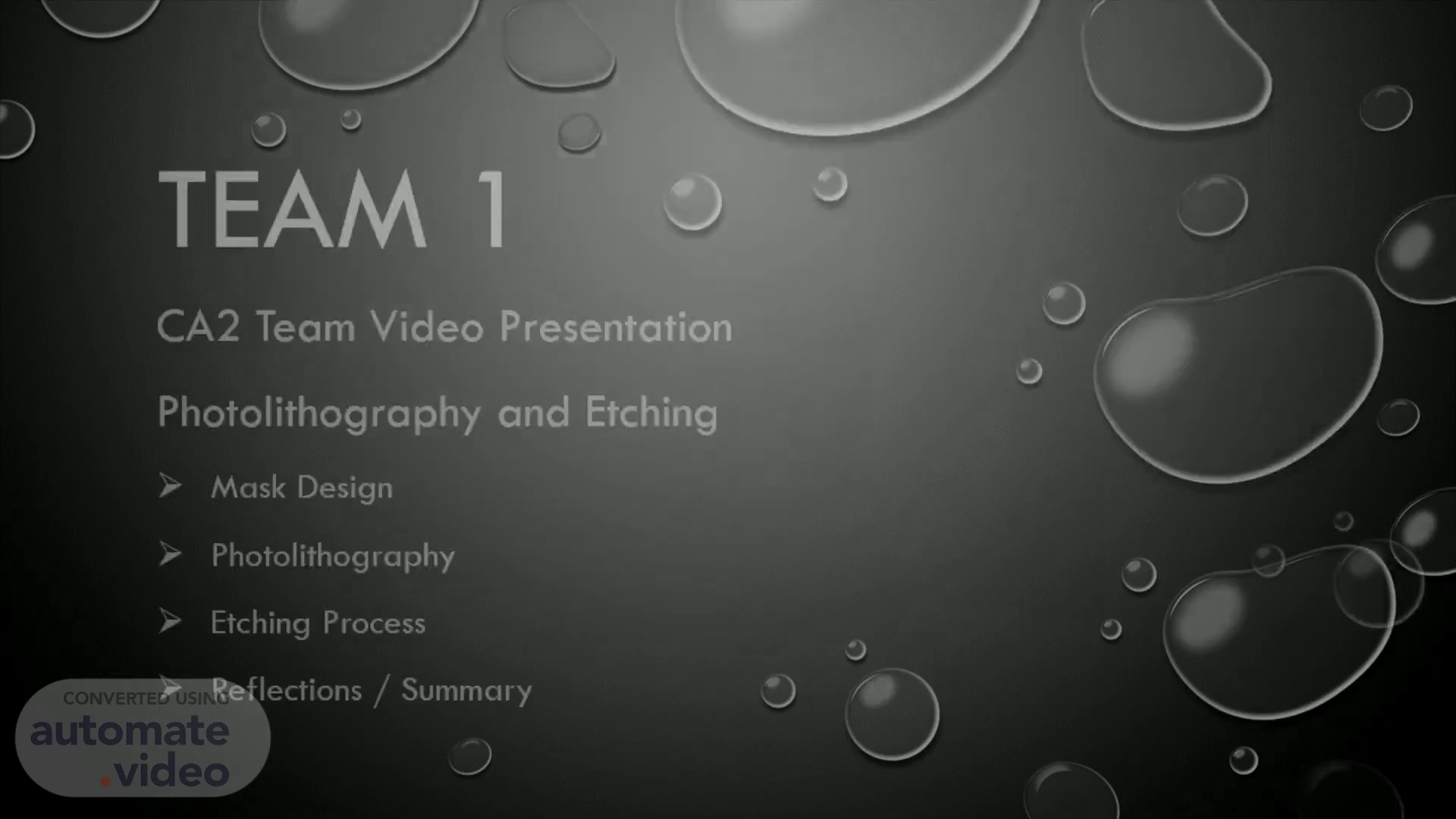Scene 1 (0s)
Team 1. CA2 Team Video Presentation Photolithography and Etching Mask Design Photolithography Etching Process Reflections / Summary.
Scene 2 (10s)
Mask design. abstract. abstract.
Scene 3 (20s)
A picture containing text, black, sign, grate Description automatically generated.
Scene 4 (44s)
Photolithography. abstract. abstract.
Scene 5 (52s)
Purposes : 1. to remove all the particulates and contaminants that may linger around the wafer. 2. Reduce any pinholes and defects 3. cleaning enhance/improve photoresist adhesion Steps involved : 1. Chemical cleaning where we used solvents and acids to remove the organic and inorganic contaminants 2. Rinse the wafer after 3. Let it dry before moving to the next step.
Scene 6 (1m 13s)
Prebake (Dehydration Bake) 1. To remove moisture from water surface 2. To promote adhesion between the surface and the photoresist Priming 1. promotes adhesion of photoresist to wafer surface 2. chill plate to cool down wafer before the photoresist coating.
Scene 7 (1m 30s)
STEP BY STEP PROCESS : place the wafer onto the vacuum chuck. Turn on the vacuum pump to apply suction onto the wafer to prevent it from moving during the spin process. Apply a controlled amount of the photoresist at the center of the wafer to have an even distribution of photoresist when spinning the waver. Apply the setting of 3000 rpm and timing of 60 sec. Start the spin coating and observe how the liquid at the center of the wafer spreads throughout the whole wafer..
Scene 8 (1m 32s)
Step 4: soft bake (pre-exposure Bake). Soft Bake helps to evaporate most of the solvents in the photoresist process Partially solidify the photoresist so that it is ready for the exposure to UV light Solvents are evaporated so that they do not affect adhesion In the lab, we put the wafer coated with photoresist on a hot plate and waited until the wafer turned reddish brown, and then we flipped the wafer over to do the same thing on the other side..
Scene 9 (1m 55s)
Lab: Soft bake. A picture containing indoor, floor Description automatically generated.
Scene 10 (2m 3s)
Step 5: alignment and exposure. Most critical process for IC fabrication If misalignment occurs the pattern will not be precisely transferred onto the wafer and device will not be constructed properly Charge coupled device (CCD) sensors are widely used in wafer alignment systems to identify the flat surface and notch in the wafer and plate respectively. In the lab, we put our wafer on a machine and we looked at the camera to measure and see if the machines systems reticles is aligned with our wafer so that the design is transferred precisely onto the wafer..
Scene 11 (2m 28s)
Lab: alignment and exposure. A picture containing indoor Description automatically generated.
Scene 12 (2m 39s)
Step 6: post exposure bake. Post exposure bake is executed to reduce the standing wave effect by baking above glass transition temperature Hotplate will bake from 110 to 130 °c for 1 minute Standing wave effect interferes with the incident and reflection light and may cause the photoresist to be over or underexposed After the alignment and exposure step, we put the wafer back onto the hot plate to bake again for 60 to 90 seconds so that our image can be clearly seen after the wet etching step..
Scene 13 (3m 3s)
Lab: post exposure bake. A picture containing indoor, floor Description automatically generated.
Scene 14 (3m 11s)
Step 7: Development. Development Solvent dissolves the softened part of the photoresist Transfer the pattern from mask (Reticle) to photoresist 3 basic steps Development Rinse Dry.
Scene 15 (3m 15s)
Step 8: Hard bake. • Evaporating all solvents in PR • Polymerize and stabilize photoresist • PR flow to fill pinhole • Hotplate 100 to 130°C for 1 to 2 minutes.
Scene 16 (3m 25s)
Step 9: Pattern inspection. Inspection determines whether the photolithography produced a desired and usable pattern • Photoresist pattern is temporary. • Can be done using Scanning electron microscope (SEM) or Optical microscope.
Scene 17 (3m 37s)
Etching process. abstract. abstract.
Scene 18 (3m 45s)
Etching Process. Etching is the process of transferring the mask design from the photolithography process to the surface of the wafer permanently Etching has two main categories: Wet Etch: Use of chemical solutions / liquid enchants Dry Etch: Plasma etching process, uses plasmas and etching gases..
Scene 19 (4m 1s)
Etching Process. Lab: Wet Etch Etch the wafer with Buffer Oxide Enchant (BOE) for around 1 minute, to remove the oxide layer that is not covered by the photoresist Strip the photoresist with Acetone, leaving only the mask design as the oxide layer.
Scene 20 (4m 19s)
u. A picture containing text yellow drawn colorful Description automatically generated.
Scene 21 (4m 29s)
Reflection / Summary. Overall, everything went successful, and the product is as expected -Here is our mask design and the finished product following the entire procedure..
